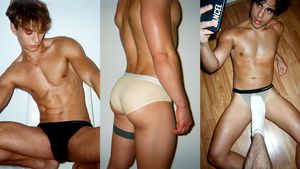The self-portrait of William Etty (1787-1849) at left shows a sandy-ginger-haired man with a sensuous mouth and foxy, almost feminine eyes. He was a shy man and remained a bachelor all his life, which at the time was practically a statement. He was a successful Royal Academy artist and a contemporary of Constable and Turner. His work fell out of favor after his death. But while he was an active painter he was both admired and condemned for his detailed renderings of the naked human body.
Critics felt he focused too much on the female buttocks, but if you Google Image search for his work, you find a surprisingly large number of male nudes, many with a focus on the male buttocks as well. Seems none of his contemporaries were interested in commenting on that.
As usual, there is no confirming sexual orientation of people long dead from a time when no one really identified as gay, so we let the paintings speak for themselves.
Of special interest is the grand work that Etty considered his greatest achievement, The Sirens and Ulysses. (See the last page of this article.) The Manchester Gallery in England has restored the large canvas, which had been in storage for almost 200 years. On its website the gallery states, "The subject of the Sirens, from Homer's Odyssey, was probably suggested by a friend. It fitted Etty's artistic purpose perfectly. He wrote: 'My aim in all my great pictures has been to paint some great moral on the heart ... the importance of resisting SENSUAL DELIGHTS'. He researched the picture thoroughly, even studying corpses for the figures of the dead sailors.
Click the gallery link to read more about Etty and the fascinating project of restoring this large canvas.
 This study is a classic example of the flexed and richly shaded buttocks for which Etty was noted.
This study is a classic example of the flexed and richly shaded buttocks for which Etty was noted.
 The Wrestlers shows off Etty's skills.
The Wrestlers shows off Etty's skills.
 In A Greek Slave, 1812, Etty teases us with a diaphanous drape over the focal point of the painting.
In A Greek Slave, 1812, Etty teases us with a diaphanous drape over the focal point of the painting.
 An Athlete Striving Upward combines tensed and relaxed muscle in one figure.
An Athlete Striving Upward combines tensed and relaxed muscle in one figure.
 An Academy study of a favored, mutton-chopped model.
An Academy study of a favored, mutton-chopped model.
 Male Nude With Arms Upstretched raises questions about Etty's sophisticated tastes.
Male Nude With Arms Upstretched raises questions about Etty's sophisticated tastes.
 In Lamentation Over the Dead Christ, Etty portays Jesus as a supple, healthy youth.
In Lamentation Over the Dead Christ, Etty portays Jesus as a supple, healthy youth.
In Male Nude Boxing we see one of Etty's favored figure models, most of whom were mature and muscular as opposed to the often youthful and gender-fluid models of the time.
 Another study that seems to be of the favored model.
Another study that seems to be of the favored model.
 Male nude study.
Male nude study.
 A good example of foreshortening and beautifully modeled flesh.
A good example of foreshortening and beautifully modeled flesh.
 Nude male study.
Nude male study.
Male nude from the back.
 The eyes are drawn to the sharp contrast of hair in the crotch. Something in Etty's usually confident anatomy is amiss here, as if part of the figure was painted out. There is a visual echo between the dark mass of curls on the figure's head and the arrow-sharp pubic patch.
The eyes are drawn to the sharp contrast of hair in the crotch. Something in Etty's usually confident anatomy is amiss here, as if part of the figure was painted out. There is a visual echo between the dark mass of curls on the figure's head and the arrow-sharp pubic patch.
 A male nude with maturing flesh, realistic in a way that moves away from the classic ideal.
A male nude with maturing flesh, realistic in a way that moves away from the classic ideal.
 His critically acclaimed salon painting of Ulysses. "Ulysses and the Sirens is one of those great efforts of my art achieved in the vigour of my life, I can never make again," Etty is quoted. Yet the Ulysses figure is almost cartoonish and has none of the sensual grace of his studies. Yet the robust masses of muscle project an unambiguous homoerotic power.
His critically acclaimed salon painting of Ulysses. "Ulysses and the Sirens is one of those great efforts of my art achieved in the vigour of my life, I can never make again," Etty is quoted. Yet the Ulysses figure is almost cartoonish and has none of the sensual grace of his studies. Yet the robust masses of muscle project an unambiguous homoerotic power.
 Ulysses and the Sirens, detail
Ulysses and the Sirens, detail


 This study is a classic example of the flexed and richly shaded buttocks for which Etty was noted.
This study is a classic example of the flexed and richly shaded buttocks for which Etty was noted. The Wrestlers shows off Etty's skills.
The Wrestlers shows off Etty's skills. In A Greek Slave, 1812, Etty teases us with a diaphanous drape over the focal point of the painting.
In A Greek Slave, 1812, Etty teases us with a diaphanous drape over the focal point of the painting. An Athlete Striving Upward combines tensed and relaxed muscle in one figure.
An Athlete Striving Upward combines tensed and relaxed muscle in one figure. An Academy study of a favored, mutton-chopped model.
An Academy study of a favored, mutton-chopped model. Male Nude With Arms Upstretched raises questions about Etty's sophisticated tastes.
Male Nude With Arms Upstretched raises questions about Etty's sophisticated tastes. In Lamentation Over the Dead Christ, Etty portays Jesus as a supple, healthy youth.
In Lamentation Over the Dead Christ, Etty portays Jesus as a supple, healthy youth. Another study that seems to be of the favored model.
Another study that seems to be of the favored model. Male nude study.
Male nude study. A good example of foreshortening and beautifully modeled flesh.
A good example of foreshortening and beautifully modeled flesh. Nude male study.
Nude male study. The eyes are drawn to the sharp contrast of hair in the crotch. Something in Etty's usually confident anatomy is amiss here, as if part of the figure was painted out. There is a visual echo between the dark mass of curls on the figure's head and the arrow-sharp pubic patch.
The eyes are drawn to the sharp contrast of hair in the crotch. Something in Etty's usually confident anatomy is amiss here, as if part of the figure was painted out. There is a visual echo between the dark mass of curls on the figure's head and the arrow-sharp pubic patch. A male nude with maturing flesh, realistic in a way that moves away from the classic ideal.
A male nude with maturing flesh, realistic in a way that moves away from the classic ideal. His critically acclaimed salon painting of Ulysses. "Ulysses and the Sirens is one of those great efforts of my art achieved in the vigour of my life, I can never make again," Etty is quoted. Yet the Ulysses figure is almost cartoonish and has none of the sensual grace of his studies. Yet the robust masses of muscle project an unambiguous homoerotic power.
His critically acclaimed salon painting of Ulysses. "Ulysses and the Sirens is one of those great efforts of my art achieved in the vigour of my life, I can never make again," Etty is quoted. Yet the Ulysses figure is almost cartoonish and has none of the sensual grace of his studies. Yet the robust masses of muscle project an unambiguous homoerotic power. Ulysses and the Sirens, detail
Ulysses and the Sirens, detail














































































